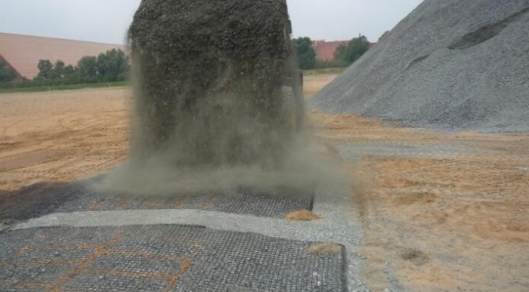- Understanding the Role of Geomembrane Liners in Waste Management
- Innovations in Geomembrane Liners for Water Management
- Geomembrane Liners: A Comprehensive Guide
- The Future of Geomembrane Liners in Civil Engineering
- Geomembrane Liners: Enhancing Landfill Stability
Manager:Alvin Wang
WhatsApp:+62 8983806051
Tel:+86 10-5797-1075
Email:steelwang@okorder.com
Address:3rd Floor, No.2 Building, No.1 Sanlihe Road
Does water go through geotextiles?
Geotextiles, engineered fabrics designed for use in civil engineering and construction projects, play a vital role in various applications, ranging from soil stabilization to erosion control. Among the diverse types of geotextiles available, plastic geogrid, wholesale geogrid, fiberglass geogrid, and glassfiber geogrid stand out for their unique properties and applications. So do these geotextiles pass water? Let’s have a look at each type’s intricacy and its evaluation of permeability to water.

Understanding Geotextiles and Their Functionality
Geotextiles are porous fabrics that are made from either synthetic or natural fibers. They are commonly used in different construction works including soil reinforcement, drainage provision, filtration protection and separation. Therefore these flexible materials give the engineers as well as the construction experts many options to consider when dealing with specific project requirements.
Plastic Geogrid: Permeability Analysis
A kind of geosynthetic made of high density polyethylene (HDPE) or polypropylene (PP), which is used to strengthen soil at the site by offering it rigidity and stability is called plastic geogrids. The use of plastic geogrids ranges from road constructions then followed by retaining walls among other embankments being slope retained.
Plastic geogrids are usually designed so as to let water go through them. However, this depends on factors such as aperture size of the grid design itself as well as method used during installation. Thus fitted out plastic geo-grids help in draining the water away hence no pooling may negatively affect building structure.
Wholesale Geogrid: Water Permeation Considerations
Wholesale is therefore cheaper than retailing since they usually come at discounts with large amounts purchased at ago for instance you can say entire roll order has been requested instead of buying per meter.These kinds of geogrids are made from HDPE, PP or polyester and manufactured in line with project specifications.
In respect of water permeability, they behave in the same way as plastic geogrids. Designed for water flow through them so that there is no clogging and saturation problems resulting into erosion of soil. As a result effective water infiltration can only be achieved if well fitted wholesale geogrids are used.
Fiberglass Geogrid: Assessing Water Flow
Fiberglass geogrids on the other hand are made by using high-strength fiberglass strands coated with a polymer resin. These grids possess high tensile strength and find application in asphalt reinforcement, pavement overlays and ground stabilization among others.
When it comes to water permeability, fiberglass geogrids tend to have low permeability because they have denser structure and surface characteristics. Directly translated though some water might still pass through its interstices this has lower overall permeability in comparison to either plastic or wholesale one. Hence whenever a user wants to install fiberglass geo-grid he or she should seriously analyze the drainage demands of the project in order put up additional ones meant for protection against contact with water substances.
Glassfiber Geogrid: Permeability Evaluation
Glass fiber grids resemble fiberglass ones much primarily because of building material qualities associated with both types of construction materials. They have very strong glass fibers which are coated with a polymer resin for durability. For sure when you think about roadworks than railway foundation stabilization down to soil backup restoral work then you must always keep glassfiber results on your mind.
In terms of their ability to allow water move across them, glassfiber geo-grids behave like fibreglass ones do. Nevertheless, the entire percolation is considerably different from that exhibited by equivalent textiles such as plastics or those bought at gross rates. The design engineer has therefore got no option but critically evaluate his/her expectations out of the project and therefore additional steps concerning drainage have to be adopted as far as glassfiber geogrids are concerned.

Conclusion
Geotextiles’ permеability to water, for example, plastic geo grid, wholesale geo grid, fiber glass geo grid and glassfiber geo grid, depends on a few things such as materials used, design and method of installation. While plastic and wholesale geogrids are generally designed to allow water to pass through them readily at lower rates of permeability; fiberglass and glassfiber geogrids exhibit lower permeability. For efficient water management and long-lasting performance of the structures involved in engineering projects and construction sector; it may be necessary for engineers plus constructors to weigh between project requirements against available geotextile options. In addition, proper installation as well as drainage considerations is very vital when applying geotextiles in constructions."
- Previous:What are the 4 functions of geotextiles?
- Next:What is the use of geogrid in road construction?
-
2024-06-12Asphalt fiberglass geogrid construction plan
-
2024-06-04Asphalt fiberglass geogrid construction plan
-
2024-05-21What is the disadvantage of geogrid?
-
2024-05-21What is the lifespan of geogrid?
-
2024-05-21What are the 3 main uses of a geotextile?






